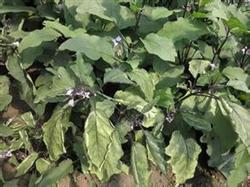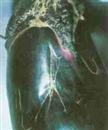Key points of eggplant cultivation techniques

One. Select high-quality seedlings: choose a seedling factory with high popularity and good reputation to book strong seedlings. 2. Preparation before planting: 1. Greenhouse disinfection: after the end of the previous stubble, clean up the residual plants in time, seal ahead of time, and sulk the shed at high temperature. two。 Application of base fertilizer: 8-10 square of mature high quality organic fertilizer was applied in advance, and calcium superphosphate 50-100kg, potassium sulfate 40-50kg and boron, iron, zinc, molybdenum and other trace elements 3-5kg were applied, and the fine land was leveled and raked for reserve. 3. High ridge cultivation and reasonable close planting: ridge height about 20cm, large row spacing 85-90cm, small row spacing 60cm, plant spacing 45-50cm, about 2000 plants per mu. Three. Planting: hole planting, it is appropriate to choose sunny afternoon or cloudy days to slow down the seedlings. Pour sole water after opening the hole. Four. post-planting management: 1. Temperature management: slow seedling stage: day 28-30 ℃, night temperature above 15 ℃, ground temperature 20 ℃. Before the beginning of fruit harvest: 25-30 ℃ in the morning, 20-28 ℃ in the afternoon, 13-20 ℃ in the first midnight, and 10-13 ℃ in the latter part of the night. Fruit harvest time: 26-32 ℃ in the morning, 24-30 ℃ in the afternoon, 18-24 ℃ in the first half of the night, 15-18 ℃ in the second half of the night, no more than 20 ℃ in overcast and rainy day, 10-13 ℃ at night. Continuous cooling in winter, strengthening cold prevention and heat preservation, ventilation and cooling in spring and summer to ensure proper temperature for childbearing. two。 Fertilizer and water management: 5-7 days after planting, slow seedling water was watered once when the seedlings began to grow. Then ploughing 2-3 times to promote root development, the last time the ridge surface will be leveled, covered with plastic film. When the door eggplant "stared", it began to pour fruit water, combined with watering per mu of diammonium phosphate 10-15kg, and then watered under the trench film every 15 days according to the weather. Watering can be reduced during the period from December to February of the following year. After March, there is a large demand for water and fertilizer, large and small ditches can be watered at the same time, one time clear water and one time fertilizer water, urea 10-15kg and potassium sulfate 10kg are applied per mu, and used alternately. 3. Plant adjustment, flower and fruit protection: generally use 2-3 dry pruning. After the door eggplant began to expand and grow, the lateral branches and old leaves under the door eggplant were removed to improve ventilation and light transmission conditions and reduce nutrient consumption. In order to prevent falling flowers and fruits, 20-30ppm 2mae 4murD can be used for dipping flowers. With the growth, the old and diseased leaves in the lower part of the plant were removed in time. 4. Harvest: door eggplant can be picked early, which is beneficial to plant growth and fruiting. It is best to harvest in the morning, so the fruit is full and the gloss is good. When harvesting, it is appropriate to use scissors or knives to cut off the stalk so as not to cut the pericarp during storage and transportation. 5. Disease and pest control: Verticillium wilt: do a good job of seed disinfection, crop rotation, root uprooting immediately after discovering the diseased plant, and take it out of the field to burn. Chemical control: irrigate the root with 500x solution of 50%DT fungicide, 500x solution of 50% carbendazim wettable powder or 500x solution of 70% dimethazone powder, each 500ml. Sclerotinia sclerotiorum: use 1500-2000 times of 50% Sukeling wettable powder, 1000 times of 50% prohydantoin wettable powder, or alternate use of 1000-1500 times of Sclerotinia net wettable powder, spray 2-3 times continuously. In winter, use 10% Chlorothalonil smoke agent or 45% Chlorothalonil smoke agent, 250g per mu. Cotton blight: at the initial stage of the disease, you can use 75% chlorothalonil wettable powder 600 times, or 58% metalaxyl manganese zinc 400-500 times, or 64% alum wettable powder 500 times, once every 7-10 days, 2-3 times. Powdery mildew: spray 15% triadimefon wettable powder 1000 times, or 40% Fuxing EC 4000 times, or 40% polysulfide suspension 500,600 times, or 50% sulfur suspension 250,300 times. Red spider and tea yellow mite: spray control with 73% ketoprofen EC 2000 times and 20% dicofol 1000 times. White whitefly, aphids: use 20% aphid smoke agent 250g/ mu smoke shed, can also use kung fu, methotrexate and other pyrethroid pesticide spray, white whitefly can also be killed with yellow board, aphids with silver gray film or protective cover silver gray film, can play a role in repelling aphids. Note: the above cultivation measures are for reference only, and the specific operation methods are expected to depend on the local planting habits and climatic conditions.
- Prev

How to prevent eggplant from setting bumps in greenhouse
When the temperature in solar greenhouse is too low, eggplant often appears pimple fruit, which is mainly concentrated in the front end of the fruit, showing a protuberance with a finger height of 0.5 cm. Breaking open the fruit, it is found that there is a large gap between the skin and pulp where there is a pimple. The cause of the disease is that the greenhouse temperature is too low, especially in special weather, for 3 consecutive days.
- Next

Planting time and method of Chinese Cabbage
Planting time and method of Chinese Cabbage
Related
- Where is it suitable to grow horseradish in China? it is expected to see the middle altitude horseradish in Alishan.
- How to prevent tomato virus disease reasonably? (Control methods included)
- Many people like to plant towel gourd on the balcony. What are the main points of this method and management?
- What crops can chili peppers be mixed with?
- Fertilization techniques and matters needing attention in Tomato
- What are the grafting techniques for peach seedlings in spring?
- Harm and control methods of root swelling disease of Chinese cabbage
- What are the pests of sweet potatoes? How to prevent and cure it?
- Symptoms, causes and Control methods of navel Rot in Tomato
- The cause of "Cucumber rotten bibcock" in Farmers' planting Cucumber and its Control Plan

